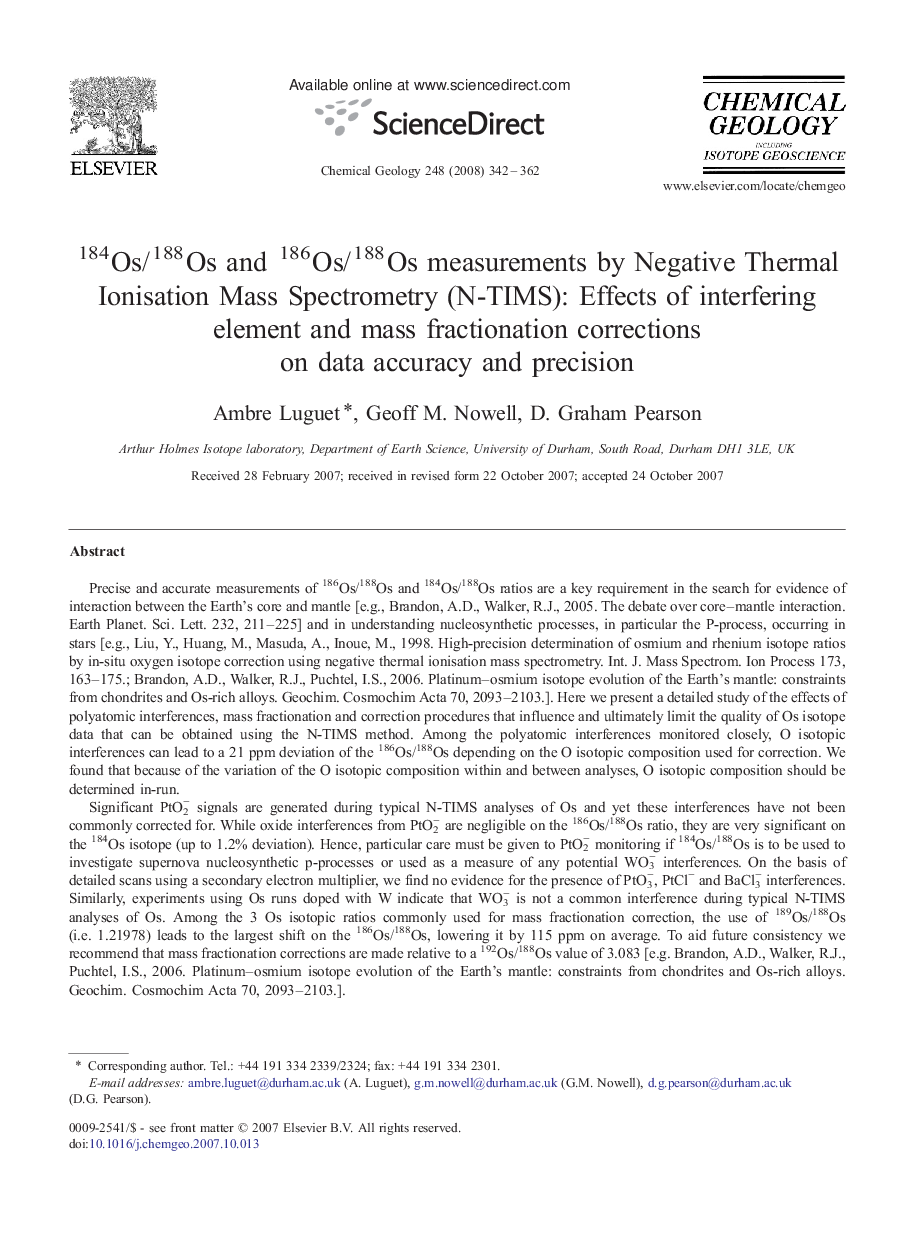| کد مقاله | کد نشریه | سال انتشار | مقاله انگلیسی | نسخه تمام متن |
|---|---|---|---|---|
| 4700874 | 1637733 | 2008 | 21 صفحه PDF | دانلود رایگان |

Precise and accurate measurements of 186Os/188Os and 184Os/188Os ratios are a key requirement in the search for evidence of interaction between the Earth's core and mantle [e.g., Brandon, A.D., Walker, R.J., 2005. The debate over core–mantle interaction. Earth Planet. Sci. Lett. 232, 211–225] and in understanding nucleosynthetic processes, in particular the P-process, occurring in stars [e.g., Liu, Y., Huang, M., Masuda, A., Inoue, M., 1998. High-precision determination of osmium and rhenium isotope ratios by in-situ oxygen isotope correction using negative thermal ionisation mass spectrometry. Int. J. Mass Spectrom. Ion Process 173, 163–175.; Brandon, A.D., Walker, R.J., Puchtel, I.S., 2006. Platinum–osmium isotope evolution of the Earth's mantle: constraints from chondrites and Os-rich alloys. Geochim. Cosmochim Acta 70, 2093–2103.]. Here we present a detailed study of the effects of polyatomic interferences, mass fractionation and correction procedures that influence and ultimately limit the quality of Os isotope data that can be obtained using the N-TIMS method. Among the polyatomic interferences monitored closely, O isotopic interferences can lead to a 21 ppm deviation of the 186Os/188Os depending on the O isotopic composition used for correction. We found that because of the variation of the O isotopic composition within and between analyses, O isotopic composition should be determined in-run.Significant PtO2− signals are generated during typical N-TIMS analyses of Os and yet these interferences have not been commonly corrected for. While oxide interferences from PtO2− are negligible on the 186Os/188Os ratio, they are very significant on the 184Os isotope (up to 1.2% deviation). Hence, particular care must be given to PtO2− monitoring if 184Os/188Os is to be used to investigate supernova nucleosynthetic p-processes or used as a measure of any potential WO3− interferences. On the basis of detailed scans using a secondary electron multiplier, we find no evidence for the presence of PtO3−, PtCl− and BaCl3− interferences. Similarly, experiments using Os runs doped with W indicate that WO3− is not a common interference during typical N-TIMS analyses of Os. Among the 3 Os isotopic ratios commonly used for mass fractionation correction, the use of 189Os/188Os (i.e. 1.21978) leads to the largest shift on the 186Os/188Os, lowering it by 115 ppm on average. To aid future consistency we recommend that mass fractionation corrections are made relative to a 192Os/188Os value of 3.083 [e.g. Brandon, A.D., Walker, R.J., Puchtel, I.S., 2006. Platinum–osmium isotope evolution of the Earth's mantle: constraints from chondrites and Os-rich alloys. Geochim. Cosmochim Acta 70, 2093–2103.].We have analysed 3 different Os reference materials. For all reference materials, we obtain an excellent agreement and very good long-term reproducibility for 190Os/188Os, 189Os/188Os and 187Os/188Os ratios compared with previously published values, or with new values obtained by MC-ICP-MS using large Os signals [Nowell, G.M., Luguet, A., Pearson, D.G., Horstwood, M.A., 2008-this volume. Precise and accurate 186Os/188Os and 187Os/188Os measurements by Multi-Collector Plasma Ionisation Mass Spectrometry (MC- ICP-MS) part I: solution analyses. Special Issue on Highly Siderophile Element Geochemistry. Chem. Geol. doi:10.1016/j.chemgeo.2007.10.020.]. The disagreement for 186Os/188Os and 184Os/188Os between our values and either previously published values, or with the new MC-ICP-MS data is more significant. Persistence of a residual correlation between 186Os/188Os and 184Os/188Os for the 3 Os reference materials following O isotope, PtO2− interference, and mass fractionation corrections suggests the presence of an additional interference affecting both 184Os and 186Os. This is unlikely to be WO3− ions since their presence during Os analysis has been discounted from our W-doped experiments. Similarly, discrepancies (70–90 ppm) in the 186Os/188Os between MC-ICP-MS results and our data when a correction for the residual correlation is applied also suggest the presence of additional interference that may affect the mass 234 during N-TIMS measurements. If 186Os is to be used to trace core–mantle interactions, and nuclear and supernova nucleosynthetic processes, further detailed investigation is required to precisely characterise these interferences and a common measurement and data processing procedure must be adopted in order to allow inter-laboratory comparisons.
Journal: Chemical Geology - Volume 248, Issues 3–4, 28 February 2008, Pages 342–362